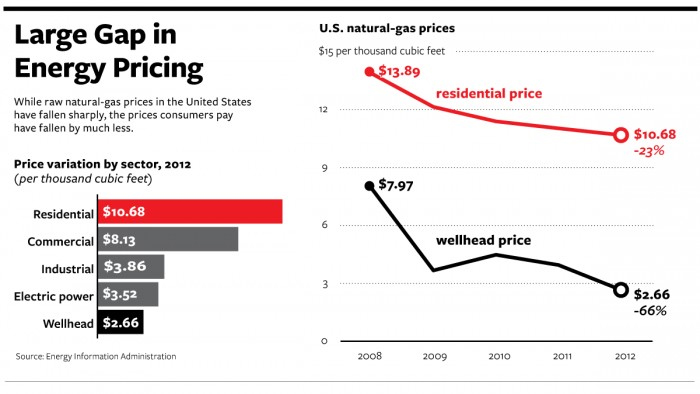Fracking has sent the price of natural gas plummeting, just not for the people who need it most.
The straight-out-of-the-ground price of natural gas is way down since the start of the boom in hydraulic fracturing. Back in 2008, users buying gas directly from drillers were paying an average of $7.97 per thousand cubic feet, according to the Energy Information Administration. By 2012, that cost—known as the “wellhead” price—had dropped to $2.66 in nominal dollars (not adjusted for inflation) resulting in a two-thirds discount in just five years.
However, those are the prices paid by pipeline operators, utilities, large industrial users, and other entities that can buy gas directly from the companies that drill for it.
By the time gas was piped into homes, individual consumers were still paying an average of $10.68 per thousand cubic feet. That’s down from $13.98 in 2008, but the $3.30 price drop is much smaller—both in absolute and relative terms—than the one that big buyers are getting further up the chain.
And consumers are about to give some of those gains back. The EIA projects that heating costs for residential customers using natural gas will rise by an average of 13 percent this winter, adding an additional $80 to the typical household’s energy bill over the course of the season.
The upcoming price hike is a sticking point for the natural-gas industry as it tries to use the promise of economic benefits to sell the public on fracking. And for customers, it’s a setback at a time when real wages are largely stagnant, household budgets are tight, and large-scale price cuts would mean much-needed relief.
budgets are tight, and large-scale price cuts would mean much-needed relief.
None of this is to say the lower gas prices haven’t been helpful for consumers; the last few years of falling per-unit costs have reversed price increases that had spiked during the millennium’s first decade.
People close to some of the most vulnerable buyers of home heating see how it’s helping their constituents.
“About six years ago, when natural-gas prices were high, it was a real crisis,” said John Wells, who directs the home-heating assistance program at Action for Boston Community Development. “Low natural-gas prices have been a godsend to low-income families.”
And low natural-gas prices help households in areas other than heating. Cheap gas has cut costs for industrial users and electricity generators, who in turn pass some of those savings to consumers.
Indeed, industrial buyers are also catching a deeper discount than individual households. In 2008, industrial users were shelling out $9.65 per thousand cubic feet of natural gas. In 2012, that was down to $3.86, a price level they hadn’t enjoyed since 1999.
So what accounts for the savings gap between large users and small ones? It’s tempting to blame utility companies, which at first blush appear to be buying low and selling high.
But—so long as the nation’s regulatory system is working properly—that can’t happen, says Amy Sweeney, a natural-gas specialist at the EIA. Utility companies are subject to a public commission that has final say over the rates they can charge. And in setting those rates, the regulators and utilities are supposed to pass any fuel cost changes—up or down—to their customers.
Instead, utility rates vary based on how much a company spends on connecting customers with the gas supplies, and that’s where consumers may see new costs. As gas has gotten cheaper, more customers are looking to get it delivered to their homes and businesses, and that has driven demand for utilities to expand the pipelines and other amenities they use to deliver gas to homes.
And unlike raw-material costs, those infrastructure costs do get passed from utilities to consumers in the form of higher gas bills.
“To some extent, what a consumer pays is going to follow, at a lag, the energy markets,” Sweeney said. “But other things—a hookup charge, a delivery charge, taxes—those can be a pretty strong component of what a customer pays.”




